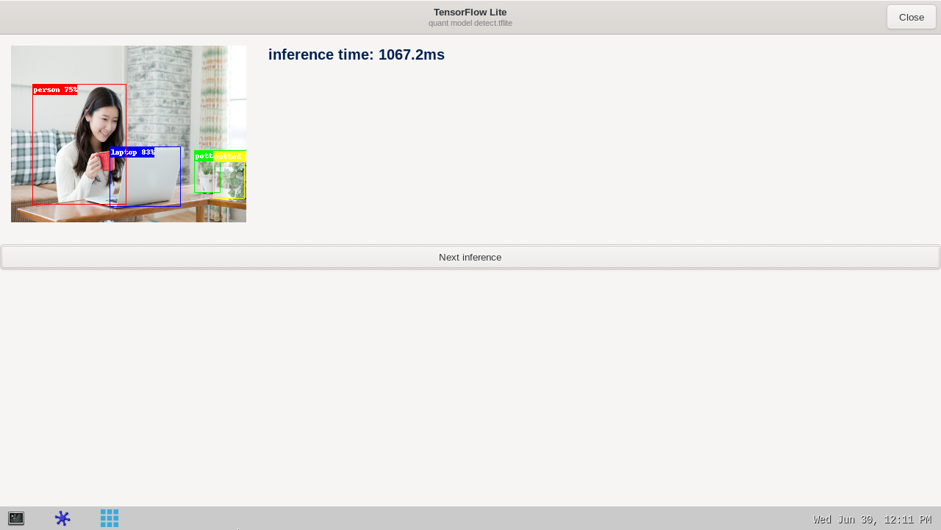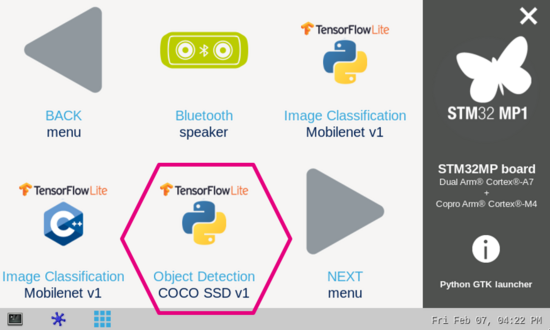This article explains how to experiment with TensorFlow Lite[1] applications for object detection based on the COCO SSD MobileNet v1 model using TensorFlow Lite Python runtime.
1. Description[edit source]
The object detection[2] neural network model allows identification and localization of a known object within an image.
The application enables OpenCV camera streaming (or test data picture) and the TensorFlow Lite[1] interpreter runing the NN inference based on the camera (or test data pictures) inputs.
It is a multi-process Python application that allows the camera preview (on the CPU core 0) and the neural network inference (using the CPU core 1) to run in parallel .
The user interface is implemented using Python GTK.
The model used with this application is the COCO SSD MobileNet v1 downloaded from the TensorFlow Lite object detection overview page[2].
2. Installation[edit source]
2.1. Install from the OpenSTLinux AI package repository[edit source]
After having configured the AI OpenSTLinux package you can install the X-LINUX-AI components for this application:
apt-get install tflite-cv-apps-object-detection-python
Then restart the demo launcher:
systemctl restart weston@root
2.2. Source code location[edit source]
The objdetect_tfl_multiprocessing.py Python script is available:
- in the Openembedded OpenSTLinux Distribution with X-LINUX-AI Expansion Package:
- <Distribution Package installation directory>/layers/meta-st/meta-st-stm32mpu-ai/recipes-samples/tflite-cv-apps/files/object-detection/python/objdetect_tfl_multiprocessing.py
- on the target:
- /usr/local/demo-ai/computer-vision/tflite-object-detection/python/objdetect_tfl_multiprocessing.py
- on GitHub:
3. How to use the application[edit source]
3.1. Launching via the demo launcher[edit source]
3.2. Executing with the command line[edit source]
The Python script objdetect_tfl_multiprocessing.py application is located in the userfs partition:
/usr/local/demo-ai/computer-vision/tflite-object-detection/python/objdetect_tfl_multiprocessing.py
It accepts the following input parameters:
usage: objdetect_tfl_multiprocessing.py [-h] [-i IMAGE] [-v VIDEO_DEVICE] [--frame_width FRAME_WIDTH] [--frame_height FRAME_HEIGHT]
[--framerate FRAMERATE] [-m MODEL_FILE] [-l LABEL_FILE] [--input_mean INPUT_MEAN]
[--input_std INPUT_STD]
optional arguments:
-h, --help show this help message and exit
-i IMAGE, --image IMAGE
image directory with image to be classified
-v VIDEO_DEVICE, --video_device VIDEO_DEVICE
video device (default /dev/video0)
--frame_width FRAME_WIDTH
width of the camera frame (default is 320)
--frame_height FRAME_HEIGHT
height of the camera frame (default is 240)
--framerate FRAMERATE
framerate of the camera (default is 15fps)
-m MODEL_FILE, --model_file MODEL_FILE
.tflite model to be executed
-l LABEL_FILE, --label_file LABEL_FILE
name of file containing labels
--input_mean INPUT_MEAN
input mean
--input_std INPUT_STD
input standard deviation
3.3. Testing with COCO ssd MobileNet v1[edit source]
The model used for test is the detect.tflite downloaded from object detection overview[2]
To ease launching of the Python script, two shell scripts are available:
- launch object detection based on camera frame inputs
/usr/local/demo-ai/computer-vision/tflite-object-detection/python/launch_python_objdetect_tfl_coco_ssd_mobilenet.sh
- launch object detection based on the pictures located in /usr/local/demo-ai/computer-vision/models/coco_ssd_mobilenet/testdata directory
/usr/local/demo-ai/computer-vision/tflite-object-detection/python/launch_python_objdetect_tfl_coco_ssd_mobilenet_testdata.sh
4. References[edit source]

